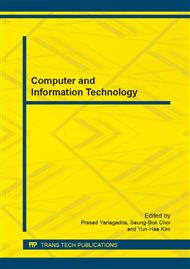[1]
Yang, Z.; Tang, W. H.; Shintemirov, A.; Wu, Q.H., Association Rule Mining-Based Dissolved Gas Analysis for Fault Diagnosis of Power Transformers, Systems, Man, and Cybernetics, Part C: Applications and Reviews, IEEE Transactions on , vol. 39, no. 6, p.597, 610, Nov. (2009).
DOI: 10.1109/tsmcc.2009.2021989
Google Scholar
[2]
Miranda, V.; Castro, A.R.G.; Lima, S., Diagnosing Faults in Power Transformers With Autoassociative Neural Networks and Mean Shift, Power Delivery, IEEE Transactions on , vol. 27, no. 3, p.1350, 1357, July (2012).
DOI: 10.1109/tpwrd.2012.2188143
Google Scholar
[3]
Rameshkumar, K.; Sambath, M.; Ravi, S., Relevant association rule mining from medical dataset using new irrelevant rule elimination technique, Information Communication and Embedded Systems (ICICES), 2013 International Conference on , vol., no., p.300, 304, 21-22 Feb. (2013).
DOI: 10.1109/icices.2013.6508351
Google Scholar
[4]
Xiaoyu Gao; Yue Hu; Qingshi Gao, The Key Points of New Fuzzy Set Theory, Fuzzy Systems and Knowledge Discovery, 2007. FSKD 2007. Fourth International Conference on , vol. 1, no., p.272, 278, 24-27 Aug. (2007).
DOI: 10.1109/fskd.2007.574
Google Scholar
[5]
Yann-Chang Huang; Huo-Ching Sun, Dissolved gas analysis of mineral oil for power transformer fault diagnosis using fuzzy logic, Dielectrics and Electrical Insulation, IEEE Transactions on , vol. 20, no. 3, p.974, 981, June (2013).
DOI: 10.1109/tdei.2013.6518967
Google Scholar
[6]
Zhangyan Xu; Dongyuan Gu; Bo Yang, Attribute Reduction Algorithm Based on Genetic Algorithm, " Intelligent Computation Technology and Automation, 2009. ICICTA , 09. Second International Conference on , vol. 1, no., p.169, 172, 10-11 Oct. (2009).
DOI: 10.1109/icicta.2009.49
Google Scholar
[7]
Alwan, H.B.; Ku-Mahamud, K.R., Optimizing Support Vector Machine parameters using continuous Ant Colony Optimization, Computing and Convergence Technology (ICCCT), 2012 7th International Conference on , vol., no., p.164, 169, 3-5 Dec. (2012).
Google Scholar
[8]
Bigdeli, M.; Vakilian, M.; Rahimpour, E., Transformer winding faults classification based on transfer function analysis by support vector machine, Electric Power Applications, IET , vol. 6, no. 5, p.268, 276, May (2012).
DOI: 10.1049/iet-epa.2011.0232
Google Scholar
[9]
Shaban, K.; El-Hag, A.; Matveev, A., A cascade of artificial neural networks to predict transformers oil parameters, Dielectrics and Electrical Insulation, IEEE Transactions on , vol. 16, no. 2, p.516, 523, April (2009).
DOI: 10.1109/tdei.2009.4815187
Google Scholar


